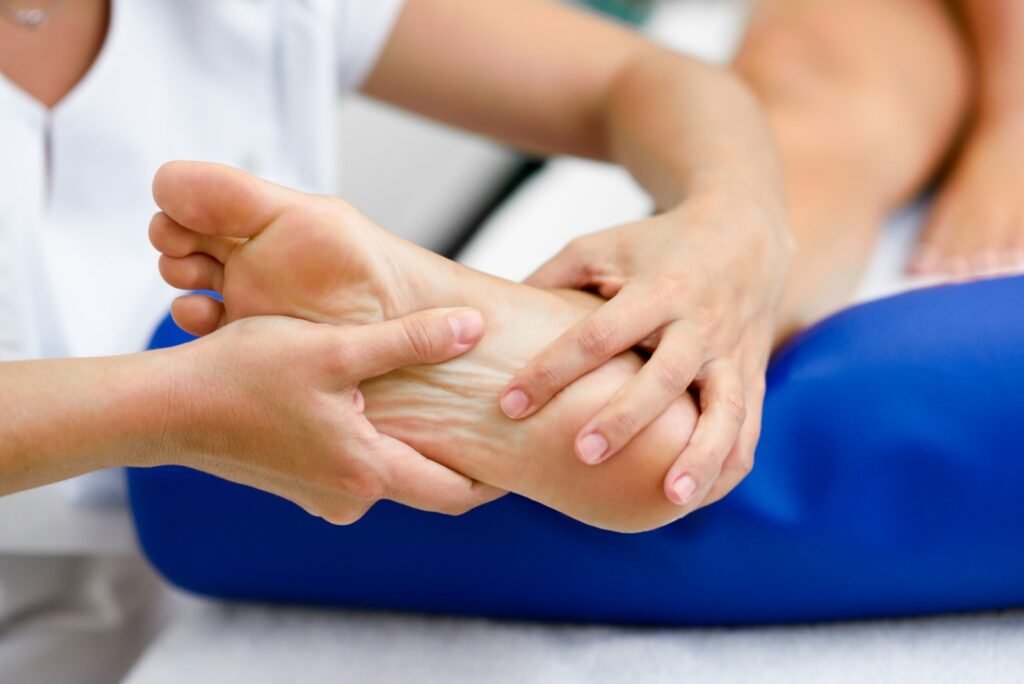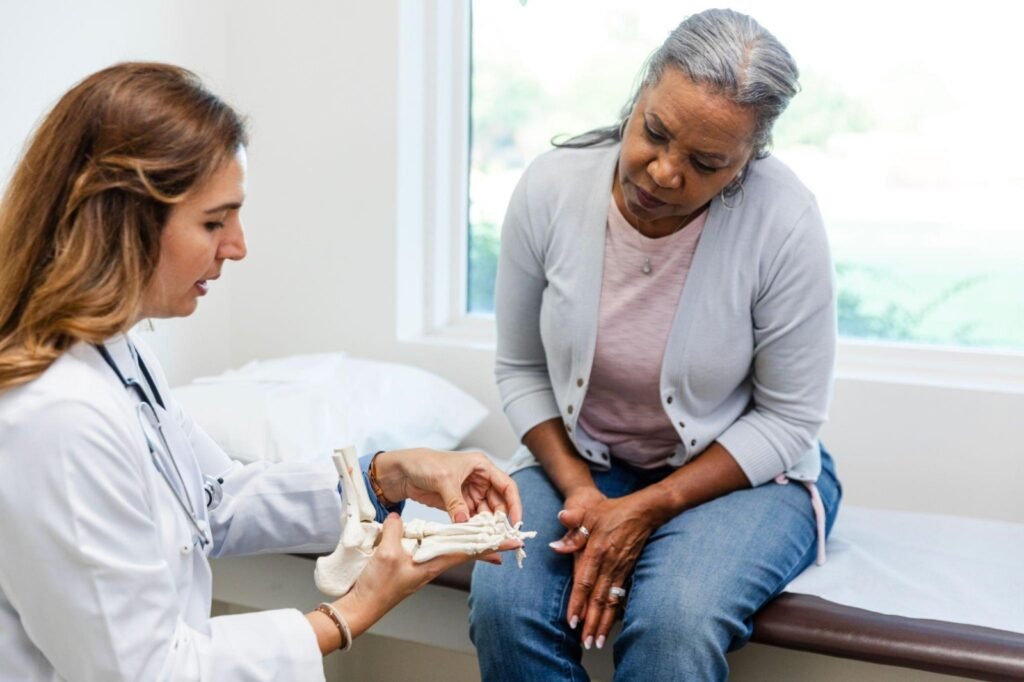ARTHRITIS

Embrace Comfort: Effective
Solutions for Arthritis
Embrace Comfort: Effective
Solutions for Arthritis
ARTHRITIS Q&A

WHAT IS ARTHRITIS?
Arthritis encompasses a spectrum of diverse conditions, each affecting the joints in distinct ways.
The various forms of arthritis can be broadly classified into two main categories: osteoarthritis and inflammatory arthritis.
- Osteoarthritis (OA): Osteoarthritis is the most common type, typically associated with ageing and wear-and-tear on the joints. It involves the gradual breakdown of cartilage—the protective tissue covering the ends of bones in a joint.
- Affected Joints: Weight-bearing joints such as knees, hips, and spine are often impacted, but any joint can be affected.
- Inflammatory Arthritis: This category includes conditions where the immune system attacks the joints, causing inflammation. Rheumatoid arthritis and psoriatic arthritis are notable examples.
- Symptoms: In addition to joint pain and stiffness, inflammatory arthritis may involve swelling, warmth, and redness around the affected joints. Fatigue and systemic symptoms may also occur.
- Affected Joints: Multiple joints are usually affected symmetrically, and the inflammation can extend beyond the joints to other organs.
- Other Types: Gout: Caused by the accumulation of uric acid crystals in the joints, often leading to sudden and severe pain, swelling, and redness.
- Ankylosing Spondylitis: Primarily affecting the spine, causing stiffness and pain in the neck and back.
- Juvenile Idiopathic Arthritis (JIA): Affecting children, JIA comprises various subtypes characterized by chronic joint inflammation. Diagnosis involves a thorough examination by a healthcare professional, including imaging studies and blood tests. Treatment approaches vary depending on the type of arthritis and may include medications, lifestyle modifications, and, in some cases, surgical intervention. Our team of specialists is dedicated to accurately identifying and effectively managing the diverse forms of arthritis, ensuring tailored care for each patient's unique condition.
WHAT ARE THE SYMPTOMS OF ARTHRITIS?
Arthritis manifests through a range of symptoms, varying in intensity and presentation depending on the specific type of arthritis.
The common symptoms encompass both physical discomfort and functional limitations in the affected joints.
- Joint Pain: Persistent pain in the joints is a hallmark symptom of arthritis. The pain may be sharp, throbbing, or aching, and it can vary in intensity.
- Joint Stiffness: Arthritis often causes stiffness in the affected joints, particularly after periods of inactivity or upon waking in the morning. This stiffness may improve with movement.
- Swelling and Redness: Inflammatory forms of arthritis may lead to visible swelling and redness around the affected joints. This is a result of increased blood flow and fluid accumulation.
- Reduced Range of Motion: Arthritis can restrict the normal range of motion in joints, making it challenging to bend, straighten, or move them fully.
- Warmth Around Joints: Inflammatory arthritis may cause an increase in temperature around the affected joints due to heightened blood flow and inflammation.
- Fatigue: Arthritis, especially in its inflammatory forms, can contribute to persistent fatigue and a general feeling of being unwell.
- Weakness and Muscle Atrophy: Prolonged joint inflammation can lead to weakness and muscle wasting around the affected joints.
- Joint Deformities: Over time, certain types of arthritis, particularly rheumatoid arthritis, may lead to joint deformities as a result of chronic inflammation and damage.
- Difficulty Performing Daily Activities: Arthritis symptoms can interfere with the ability to perform routine activities such as walking, climbing stairs, or grasping objects.
- Systemic Symptoms: Inflammatory arthritis may involve systemic symptoms such as fever, weight loss, and an overall sense of malaise.
It's crucial to note that arthritis symptoms can vary widely among individuals, and early detection and intervention are key to managing the condition effectively. If experiencing persistent joint pain or related symptoms, consulting with a healthcare professional at PR Foot and Ankle Surgeons, particularly a rheumatologist or orthopedic specialist, is essential for an accurate diagnosis and tailored treatment plan.


WHAT ARE THE RISK FACTORS FOR ARTHRITIS?
The development of arthritis is influenced by a combination of genetic, environmental, and lifestyle factors. Understanding these risk factors is crucial for identifying individuals who may be more predisposed to arthritis.
Here is a detailed explanation of the key risk factors associated with arthritis:
- Age: The risk of arthritis increases with age. Osteoarthritis, the most common type, is often associated with wear and tear on the joints over time.
- Gender: Certain types of arthritis, such as rheumatoid arthritis, are more prevalent in women. However, gout is more common in men.
- Genetics: A family history of arthritis, especially rheumatoid arthritis and ankylosing spondylitis, can increase the risk of developing these conditions.
- Joint Injuries: Previous joint injuries, such as fractures or ligament tears, may predispose individuals to the development of arthritis, particularly osteoarthritis.
- Obesity: Excess body weight places increased stress on weight-bearing joints, such as the knees and hips, contributing to the development and progression of arthritis, especially osteoarthritis.
- Occupational Factors: Certain occupations that involve repetitive joint movements, heavy lifting, or prolonged periods of kneeling or squatting may increase the risk of arthritis.
- Infection: Infections, particularly in the joints, can trigger inflammatory forms of arthritis. Reactive arthritis may develop following a bacterial infection.
- Autoimmune Diseases: Individuals with autoimmune diseases, such as lupus or psoriasis, have an increased risk of developing arthritis, particularly those of an inflammatory nature.
- Smoking: Smoking has been linked to an increased risk of developing rheumatoid arthritis and may contribute to the severity of the disease.
- Hormones: Hormonal factors, especially in women, may play a role in certain types of arthritis. For example, the onset of rheumatoid arthritis is often associated with hormonal changes.
- Joint Misalignment: Structural abnormalities or joint misalignments from conditions like hip dysplasia or scoliosis can contribute to the development of arthritis.
- Metabolic Factors: Conditions like diabetes and metabolic syndrome may increase the risk of developing osteoarthritis.
Understanding these risk factors allows healthcare professionals to identify individuals at higher risk of arthritis and implement preventive measures or early interventions to manage the condition effectively. Lifestyle modifications, weight management, and addressing joint injuries can play a crucial role in reducing the impact of these risk factors on arthritis development. Regular check-ups and consultations with healthcare providers are essential for those with multiple risk factors.
HOW DOES MY PODIATRIST DIAGNOSE ARTHRITIS?
Diagnosing arthritis in the feet, ankles, and lower extremities is a specialized task performed by podiatrists at PR Foot and Ankle, who are foot and ankle experts. The diagnostic process involves a thorough examination and may include various tools and tests.
Here's a detailed explanation of how our podiatrist typically diagnoses arthritis:
- Clinical History and Physical Examination:
The initial step involves a comprehensive discussion of the patient's medical history, including any symptoms, previous injuries, and family history of arthritis. A thorough physical examination of the feet and ankles is conducted to assess joint function, swelling, deformities, and overall foot structure. - Imaging Studies:
Podiatrists often use imaging studies to visualize the internal structures of the foot and identify signs of arthritis. X-rays provide detailed images of bones and joint spaces, helping to assess joint damage, cartilage loss, and bone spurs. In some cases, additional imaging modalities such as magnetic resonance imaging (MRI) or computed tomography (CT) scans may be recommended for a more detailed view. - Laboratory Tests:
Blood tests may be conducted to check for markers of inflammation and antibodies associated with autoimmune forms of arthritis, such as rheumatoid arthritis. Elevated levels of certain markers can provide valuable information for diagnosis. - Joint Aspiration (Arthrocentesis):
In cases where inflammatory arthritis is suspected, the podiatrist may perform joint aspiration, a procedure involving the removal of a small sample of synovial fluid from the affected joint. Analysis of this fluid can help confirm the presence of inflammation and identify the type of arthritis. - Ultrasound:
Ultrasound imaging may be used to visualize soft tissues, including tendons and joints. It can provide real-time images that aid in assessing joint inflammation and fluid accumulation. - Functional and Gait Analysis:
Observing how a patient walks (gait analysis) and assessing functional aspects of foot movement can provide valuable insights into the impact of arthritis on mobility and overall foot function. - Tissue Biopsy (Rarely):
In some cases, a tissue biopsy may be performed to examine a small sample of joint tissue for signs of inflammation or damage. This is a less common diagnostic tool and is typically reserved for specific clinical situations.By integrating these diagnostic methods, podiatrists can accurately identify the presence of arthritis, determine its specific type, and formulate an individualized treatment plan. Early diagnosis is crucial for implementing timely interventions to manage symptoms, slow the progression of the disease, and improve the overall quality of life for individuals with arthritis in the feet and ankles.



